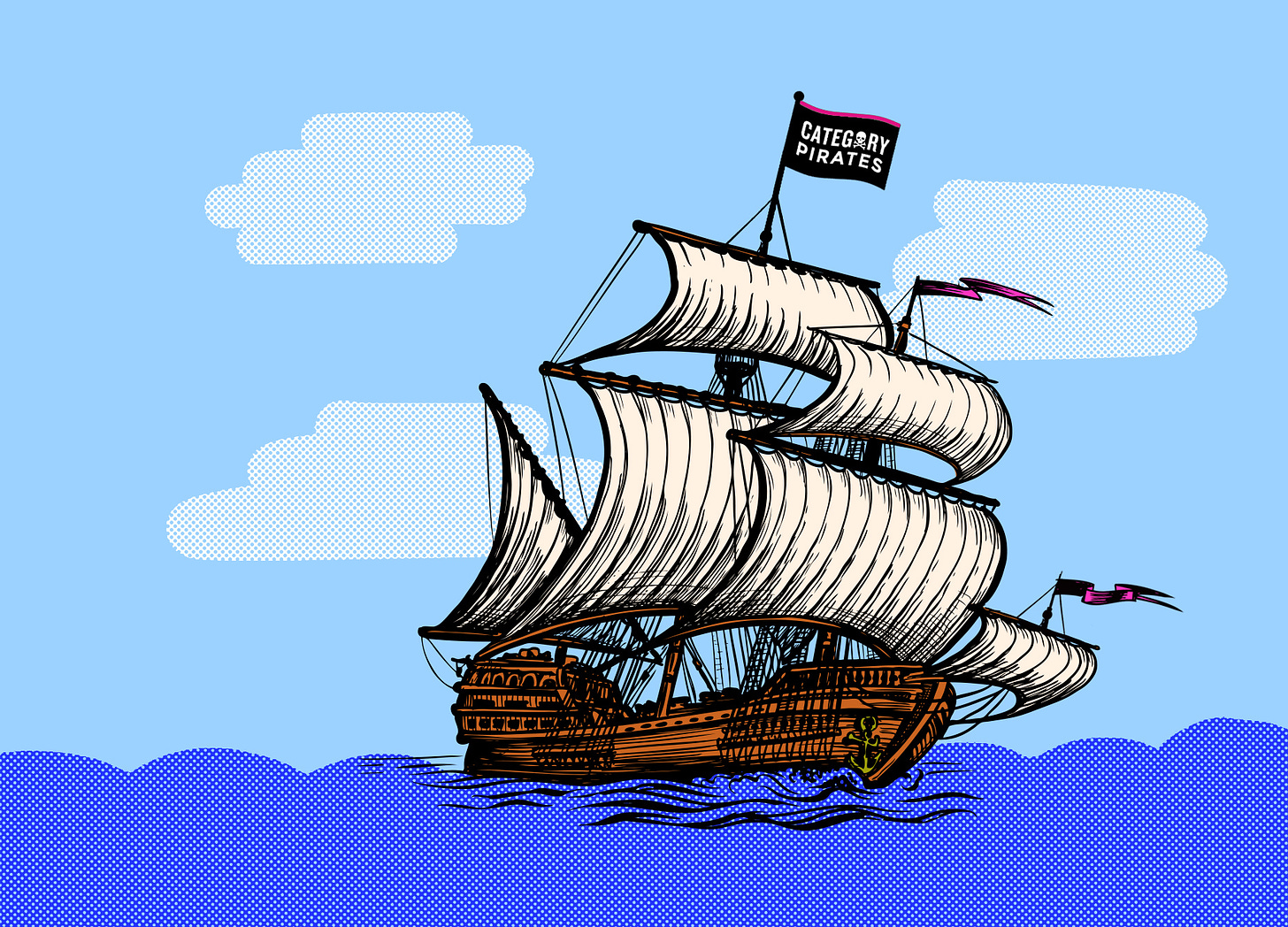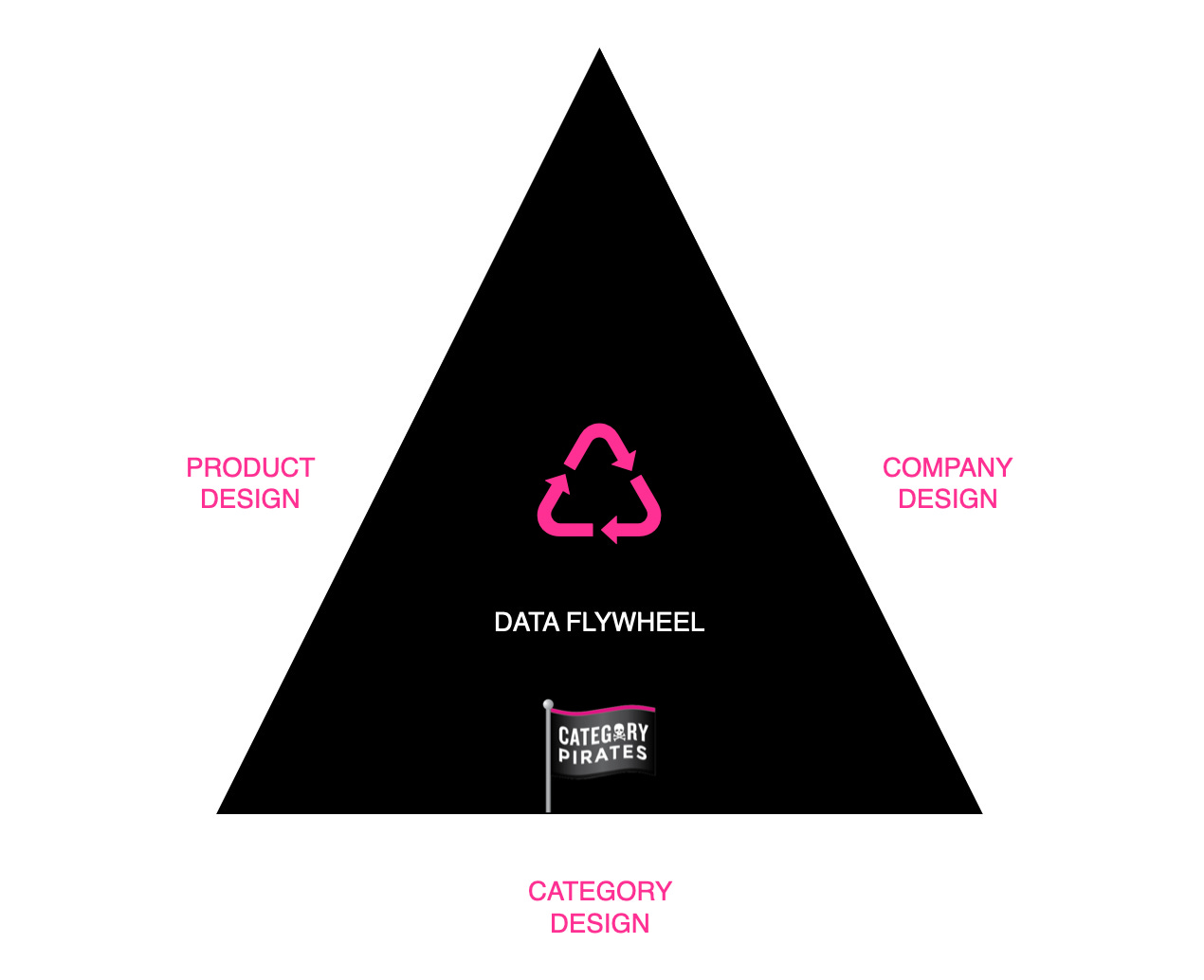How To Apply The Magic Triangle, With Examples From DoorDash And Tesla
See how these Category Kings synchronized product, company, and category design.
Dear Friend, Subscriber, and Category Pirate,
This week’s Category Design Tip will show you how Category Kings prosecute The Magic Triangle.
We get a lot of questions about how to apply The Magic Triangle to product, company, and category design. All three sides are important. But when you don’t have clarity on the category, no amount of product-tweaking or business-model-banging is going to make a difference.
So we’re sharing a few examples to explain how it works.
To chart your own category course (our mini-books are the best maps), hop aboard The Pirate Ship and subscribe below:
The Magic Triangle
The Magic Triangle has three sides: product design, company design, and category design.
Product Design: The purposeful building of a product and experience that solves the problem the category needs solved. The goal here is “product/category fit.”
Company Design: The purposeful creation of a business model and an organization with a culture and point of view that fits with the new category. The goal here is to engineer the right business model and missionary team for the problem you are looking to solve.
Category Design: The mindful creation and development of a new market category, designed so the category will pull in customers who will then make the company its King. This is about teaching the world to abandon the old and embrace the new.
All three sides work together and balance each other to exert great force on a company’s success and value.
When entrepreneurs successfully prosecute this Magic Triangle, they change the world.
The big question is, “How?”
Doordash
DoorDash started as a local delivery service in Palo Alto, California.
Today, it’s an international Category King that operates in more than 7,000 cities across the United States, Canada, Australia, and Japan.
Here’s how it synchronized all three sides of The Magic Triangle to dominate food delivery, with detailed explanations from a Twitter thread by co-founder Evan Moore.
Product Design
In 2012, four Stanford students (Tony Xu, Stanley Tang, Andy Fang, and Evan Moore) went door-to-door interviewing local business owners.
In a small macaroon shop, they realized one of the owner’s core issues — deliveries. She didn’t have any drivers to fulfill orders, so she delivered everything herself. The students heard the same thing over and over:
Deliveries are painful.

Company Design
After setting up a delivery service, the four students started delivering food from local restaurants to other students on campus.
And they had a breakthrough. Most restaurants in the Palo Alto area didn’t deliver, even though there was customer demand for it. They realized their order fulfillment and delivery business model was viable and possible.
So they began convincing restaurants to try the service.

Category Design
Naturally, DoorDash faced competition from local delivery services.
But one of its founders, Evan Moore, shared the company’s key to becoming a Category King. “We were able to be far more efficient than our competitors even before our series A, just from smartly solving for an on-demand model with three sides.”
The three sides: delighting customers, merchants, and drivers.

Today, DoorDash commands over 60% of the U.S. food-delivery market share.
It’s closest competitors?
UberEats at 31%, and GrubHub at 9%.
Tesla
We’ve written about the investing advantages of Tesla Superconsumers.
But let’s look at how Tesla used The Magic Triangle to define and dominate a new and different category.
Product Design
Since 2003, Elon Musk has been announcing to the world, “We believe internal combustion engines are polluting the planet and contributing to global warming, and we are going to work toward solving this problem by inventing electric vehicles at scale.”
That’s why Tesla is not just a car manufacturer—it’s a sustainable energy manufacturer.
Tesla simply began by building zero-emission vehicles. And its mission, accelerating the world’s transition to sustainable energy, is apparent in every product it designs.
Zero-emission electric vehicle = Replacing petroleum-based fuels (90% of transportation energy in the U.S.) with clean energy
Solar panels = Replacing electricity produced by fossil fuels (60% of electric energy in the U.S.) with clean energy
Batteries that store clean energy = Reducing residential greenhouse gas emissions (emissions from businesses and homes are primarily from fossil fuels)
Tesla’s products not only fit the company’s mission—but they also fit a specific sustainable energy need.
Company Design
Missionaries have no secrets when it comes to their vision for the world.
That’s why Elon Musk open-sourced Tesla’s patents. (Note: The emphasis is our own.)
“Tesla Motors was created to accelerate the advent of sustainable transport. If we clear a path to the creation of compelling electric vehicles, but then lay intellectual property landmines behind us to inhibit others, we are acting in a manner contrary to that goal. Tesla will not initiate patent lawsuits against anyone who, in good faith, wants to use our technology.
Elon Musk understands that Tesla alone cannot achieve the mission of building electric cars fast enough to address the carbon crisis. So he made Tesla’s intellectual property accessible. The more, the merrier.
On top of that, he also refused to partner with car dealerships so Tesla can sell its vehicles at fixed, easy-to-understand prices.
Category Design
Tesla doesn’t promote the “Tesla” brand.
They promote “electric vehicles” and, more broadly, “sustainable energy” (the category). Like all category designers, the company and product do not fit into old boxes. They are new. They are different. They cannot be compared to what came before.
Once you go Tesla, you don’t go back.
That’s because no other car brand is a credible substitute for a Tesla.
And today, Tesla is the dominant EV company in the U.S. with about 63% market share.
If you are successful at prosecuting all 3 sides of The Magic Triangle, you will unlock a company’s most valuable asset: your data flywheel.
Data flywheels are how you can anticipate the direction of future headwinds and tailwinds.
Data is the culmination of insights you capture from your category, customers, competition, and your opportunistic lens on how to best use those insights to expand your category, create a new category, and/or partner with other companies in order to achieve one of these two outcomes.
And once you capture the data, your flywheel goes round and round.
A breakthrough product, combined with an innovative business model, framed within a new and different future for the customer/consumer/user has the highest likelihood of becoming a Category King or Queen.
Once a Category Queen is established, data accumulation creates an “unfair advantage” for the company.
This “unfair advantage” means the Category King or Queen is best positioned to take advantage of the next “category creation” opportunity.
And so on, and so forth.
Why Category Design Is The Single Point Of Failure In The Magic Triangle
Now, let’s tie this all together.
Every company faces 3 risks when forging its way in the world:
Execution Risk (“Can we create a meaningful product in the time frame that matters?”)
Competition Risk (“Are we the team and business capable of winning the category battle?”)
Category Risk (“Are we Naming & Claiming the category wherein we are the undisputed King or Queen?”)
However, when it comes to prosecuting The Magic Triangle, there is only one single point of failure.
You can get the product wrong and tweak it over time. You can get the company/team/business model wrong and tweak it over time. But if you get the category wrong, you’re finished.
No food delivery, no DoorDash
No sustainable energy, no Tesla
Having a category to market yourself within, in addition to breakthrough product and company design, is what allows you to separate yourself further and further from any and all competition—creating the perception of being irreplaceable.
That’s the “magic” of the Magic Triangle.
Arrrrrrr,
Category Pirates






You guys mention the book “Innovator's Dilemma” which one as there are many from the same author.
Thanks